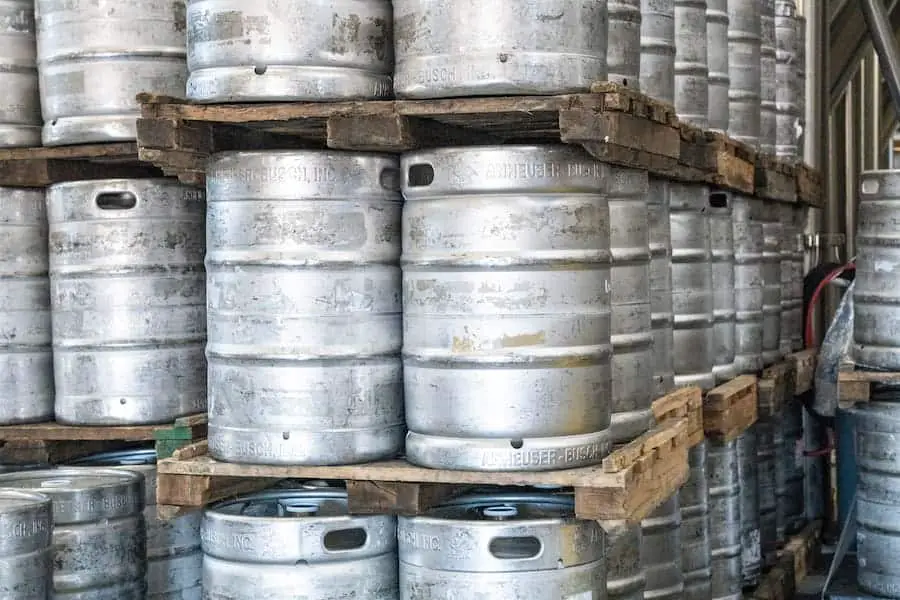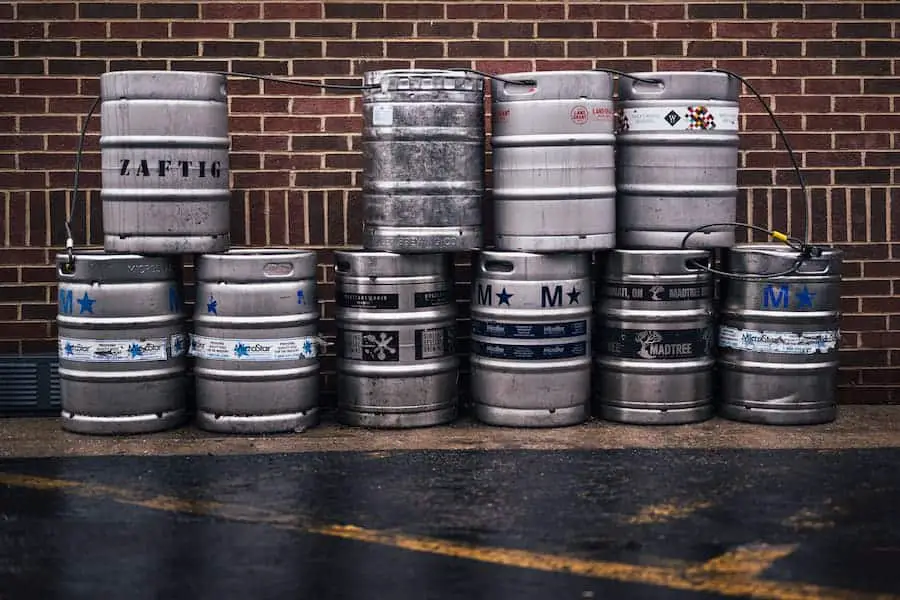If you buy something through a link in our posts, we may get a small share of the sale.
It is essential to know how to keep a keg cold, especially if you will be hosting a party or planning an event where beer is the main attraction. You can also be traveling with a keg and want to make sure it stays cold the whole time.
Contents
How to Keep a Keg Cold
The best, cheapest, and readily available way to keep a keg cold is using a bag of ice. Ensure the ice covers as much of the keg as possible to keep it cold for a long time. Other ways are using the refrigerator, thermoelectric cooling unit, or a kegerator.
Did you know that the temperature of your beer can affect how it tastes? Drinking it at your preferred temperature can make all the difference. A cold keg will give you a colder and crisper taste, while a warmer keg will give you a smoother and maltier flavor.

When it comes to keeping your keg cold, you have a few different options. You don’t have to use the same method for every keg, either. If traveling with one, for example, it might be a good idea to use an ice bath. If you are in the house or at a party, you may have other options.
Using a Bag of Ice
This is the most popular and cheapest way to keep a keg cold. You can use any ice, but it is best to use larger chunks instead of small cubes. This will help the ice stay in contact with the keg for a longer time.
The following are the steps of using a bag of ice:
- In your bag, place the large cubes in a bag, and then place the keg in the bag.
- Pack as much ice around the keg as possible to keep it cold for a long time and to avoid melting.
- If you are going to be transporting the keg, make sure to pack the ice in a cooler and wrap the keg in a towel to keep it insulated.
- You can now go and enjoy your party or event!
Advantages
- Inexpensive
- Can use any ice
- Easily accessible
- Cools keg quickly
Disadvantages
- Ice melts and needs to be replaced often
- It can be challenging to keep keg in contact with ice
Using a Kegerator
A kegerator is a mini refrigerator specifically designed to store and serve beer kegs. It is an excellent option if you want to have a keg at home or at a party. They come in different sizes, so you can choose a kegerator that best fits your needs.
- Connect the carbon dioxide and beer lines to the keg
- Install the tap on the top of the kegerator
- Open the CO2 valve and let it flow. The output pressure should be about 12-14 PSI
- Check the keg’s temperature and ensure it is below 38 degrees Fahrenheit
- Align the keg with the connector on the bottom of the kegerator
- Push down on the keg until you hear a click. This will connect the keg to the kegerator
- Disconnect the keg by pushing down on it and turning it counterclockwise
- Make sure to close the CO2 valve when you are finished
Using a kegerator is simple and easy. You can have a cold beer in minutes without having to worry about ice or refrigeration.
Advantages
- Maintains temperature
- Easy to use
- Comes in different sizes
Disadvantages
- Can be expensive
- Not easily portable

Using Thermoelectric Cooling Unit
A thermoelectric cooling unit is a good option if you want to keep your keg cold without having to use ice or a refrigerator. These units plug into the wall and use electricity to keep the keg at the desired temperature.
It has a thermostat to control the temperature and a fan to circulate the air. This will keep your keg at the perfect temperature without using ice or a refrigerator.
- Plug the cooling unit into an outlet and turn it on
- Place the keg on the cooling unit
- Set the thermostat to the desired temperature
- The unit will keep the keg at the desired temperature and will notify you when the keg is cold
Some things to keep in mind when using a thermoelectric cooling unit:
- Make sure the cooling unit is in a well-ventilated area
- Do not place the keg near any heat sources
- Clean the cooling unit regularly
Advantages
- Doesn’t require ice
- No need to store it in the refrigerator
- Can be used for other items
Disadvantages
- Requires electricity
- Not suitable for traveling
Using a Keg Tub
A keg tub is a great way to keep your keg cold if you host a party or have people over. It is a large container that can hold multiple kegs and has an ice bath to keep them cold.
The tub is made of plastic and has a lid to keep the ice in. Most have a capacity of 7.75-18 gallons. It also has a stopper so you can quickly pour your beer.
- Place the keg tub on a level surface- Placing it on a level surface will help keep the kegs in place
- Place ice in the tub- You can use regular ice or crushed ice
- Place the kegs in the tub. Make sure they are in contact with the ice
- Pour your beer. The stopper will help you pour your beer quickly and easily
Advantages
- Holds multiple kegs
- Keeps kegs cold
- Pours beer quickly and easily
Disadvantages
- Need access to ice

Using a Keg Jacket
A keg blanket is a great way to keep your keg cold if you don’t have access to a refrigerator or ice. This is an insulated blanket that wraps around the keg and helps to keep it cold.
It is made of foam insulation and has a Velcro closure. This will help keep the keg cold for an extended time. One example of a keg blanket is the Keg-O-Matic. It has an outer shell of ballistic nylon and is machine-washable. It also has a neoprene material to keep the keg insulated.
- Wrap the keg jacket around the keg- It should be snug and not too tight
- Close the Velcro closure
- Place the keg in a cold area to help keep the keg cold
- Make sure it is tight and secure, and free from any objects
Advantages
- Keeps keg cold for an extended time
- Machine-washable
- The inner neoprene material is waterproof
- Portable and easy to store
Disadvantages
- May not keep keg as cold as other methods
- Not as durable as other methods
Keg Sheet
A keg sheet is a thin, lightweight material that works to keep a keg cold. It reflects light and heats away from the keg, which helps to keep the beer cold. Keg sheets can be placed around the outside or on top of the keg. Some people also use them to insulate their kegs, when they are not in use.
There are a few different types of keg sheets available on the market. Some are made from foam, while others are made from a reflective material. The type of keg sheet you choose will depend on your specific needs and preferences.
- Choose the right keg sheet: There are a few different types of keg sheets available, so make sure you choose the one that is best for you
- Place the keg sheet around the keg. Make sure it is snug and not too tight
- Reflect the light and heat away from the keg. The keg sheet should reflect the light and heat away from the keg to keep it cold
- The keg sheet can also be used to insulate the keg when it is not in use. This will help keep the beer cold and prevent it from spoiling
Advantages
- Does not require ice to keep the keg cold
- Can be used to insulate the keg when it is not in use
- Lightweight and easy to transport
Disadvantages
Is It Necessary to Keep Keg Cold?
Yes. It is essential to keep a keg cold because the warmer the beer gets, the more carbon dioxide it will expel. When serving your keg, you will want to make sure it is cold to avoid a foam headache.
Additionally, it can produce less carbon dioxide when the beer warms up. This will make your beer taste flatter and less carbonated. Keeping a keg cold is crucial for the taste of the beer and the preservation of the beer. A warmer keg can cause the beer to become sour or taste funky.
How Do Large Distillers Keep a Keg Cold?
One of the biggest challenges for distillers is keeping kegs cold. In order to produce a consistently high-quality product, the fermentation process must be as stable as possible. Distillers use various methods to keep their kegs cool, including refrigeration and insulation.
One common method is using glycol to cool the kegs. Glycol is a refrigerant circulated through a system of pipes and coils. This method can be used for both large and small distilleries.
Another common method is using ice water. Distillers will often use an insulated container to keep the water cold. Some distillers will also freeze the water to create a more efficient cooling system.

Frequently Asked Questions
How Long Will Keg Stay Cold Without Ice?
The time a keg can stay cold without ice is dependent on a variety of factors, including the type of keg, the temperature outside, and how often the keg is opened. In general, a keg can stay for eight hours without ice if it is not opened.
What Is the Recommended Temperature for Storing Keg?
The best temperature for storing keg is 38-40 degrees Fahrenheit. The yeast will remain dormant at this temperature, and the beer will not spoil.
How Long Should a Keg Sit Before Tapping It?
A keg should sit for one to two hours before tapping it to allow the CO2 to settle. If you do not wait, the beer will be carbonated and difficult to pour.
Conclusion
There are a variety of ways to keep your keg cold. Whether you are using a koozie, a jockey box, or a keg tub, there is a method that will work for you. Keep in mind the temperature outside and how often you plan to use the keg.

